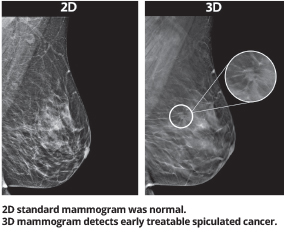Frequently Asked Questions
Got questions about breast health? Our experts have answers.
Many of our patients have similar concerns about women’s health, so we’ve compiled their top questions and added answers from our healthcare providers.
- Schedule the screening when your breasts are least likely to be tender. If you still get a monthly period, this is likely the week after you finish your cycle.
- Bring any previous mammogram images if this is your first time being screened with us.
- Don’t apply deodorant or powder before your mammogram. Metallic particles from these products could show up your mammogram and create confusion.
- Take an over-the-counter pain medication about 1 hour before your mammogram to ease any possible discomfort from the exam.
 3D breast tomosynthesis, also referred to as 3D mammography, is the latest, FDA-approved technology in breast imaging and allows radiologists to examine breast tissue one layer at a time. This type of imaging converts conventional two-dimensional digital images of the breast into a stack of 1 millimeter layers or “slices” to create a three-dimensional image of the breast. Breast tissue detail is then examined using the two-dimensional image as well as the three-dimensional image.
3D breast tomosynthesis, also referred to as 3D mammography, is the latest, FDA-approved technology in breast imaging and allows radiologists to examine breast tissue one layer at a time. This type of imaging converts conventional two-dimensional digital images of the breast into a stack of 1 millimeter layers or “slices” to create a three-dimensional image of the breast. Breast tissue detail is then examined using the two-dimensional image as well as the three-dimensional image.
Breasts are made up of a mixture of fibroglandular tissue and fatty tissue. The breast is considered to be dense if there is a greater percentage of fibroglandular tissue as compared to fatty tissue. “Breast density” is a term used to describe the amount of fat relative to fibroglandular tissue that the radiologist sees on a mammogram.
Radiologists subjectively characterize each mammogram into four categories. These categories are listed below in order from least dense to most dense. If you fall into the heterogeneously dense tissue or extremely dense tissue categories, then you are considered to have dense breasts. Approximately half of the population is considered to have dense breasts.
The following are the four categories of breast density:
- ALMOST ENTIRELY FATTY
- SCATTERED FIBROGLANDULAR TISSUE
- HETEROGENOUSLY DENSE TISSUE
- EXTREMELY DENSE TISSUE
Mammograms remain the gold standard for breast cancer screening. There is no other screening modality recommended to replace mammography. Breast ultrasound or breast MRI may be recommended for certain patients with additional risk factors such as family history. All additional examinations are done in addition to your mammogram, not in replacement of your annual mammogram.
For all categories of breast density, studies indicate that 3D Tomosynthesis is superior to 2D mammography alone. Because of these findings, Women’s Imaging Center became the first fully accredited imaging center in Orange County to provide this supplemental screening as part of our routine screening exam.
For our Women’s Imaging Center patient population, 2D mammography combined with 3D Tomosynthesis has shown a
- 27% increase in overall cancer detection
- 40% increase in invasive cancer detection
- 15% decrease in false positive findings
If you still have questions or concerns regarding your individual risk, you can call Women’s Imaging Center to inquire about Genetic Counseling. Women’s Imaging Center has an established relationship with certified Genetic Counselors who are licensed by the California Department of Public Health and Board certified by the American Board of Genetic Counseling.
